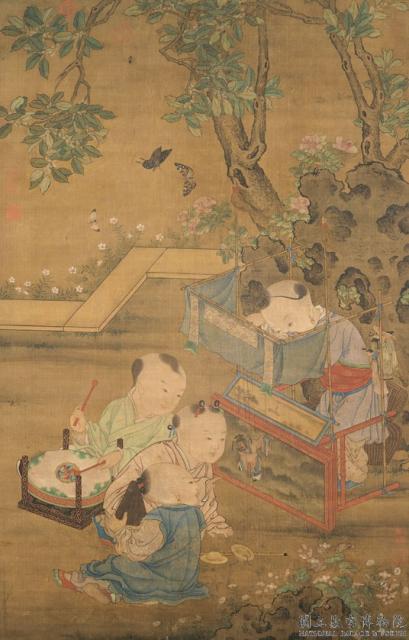TELDAP Collections
| Delineating Appearances: Portrait Painting |
|
Text by Professor Lin Changte, Department of Fine Arts, National Taiwan Normal University
 Photograph of Empress Wanrong
(Source: National Palace Museum)
Gobulo Wanrong was born in a turbulent era. As the last empress of China during the Qing Dynasty, she was thrust upon the historical stage under shiny spotlights. By now, however, the curtain has long risen and fallen, and what remains of Empress Wanrong are just some accounts of the vicissitudes of her life and a few pictures. Nowadays, we can sketch out her life based on the images of her catalogued in the NBINet. But how did people record the appearance of a person before photography was introduced to the East?
 Half-length portrait of Empress Xiaocigao, Ming Dynasty
(Source: National Palace Museum)
An early example of Chinese portrait painting is the Silk Painting Depicting a Man Riding a Dragon dating from the Warring States Period. It depicts the profile of a scholar-official from the State of Chu (the tomb occupant) ascending to heaven on a dragon. His calm demeanor is presented by graceful and simple lines. A later example is the Silk Painting from Tomb No. 3 of Han Dynasty in Mawangdui (in Changsha) dating from the Western Han Dynasty. It illustrates how the wife of the Marquis of Dai Licang, leaves earth to ascend to heaven. This painting is in the form of a funeral banner, and its flying characters are executed in a fine linear style, showing the seriousness and delicate elements of the painting that are unlike the meticulously painted portraits of nobles. As for the Han Dynasty portrait stones, they demonstrate the daily life of ordinary people and historical events such as archery, harvesting, salt mining, and Jing Ke’s attempted assassination of the King of Qin Dynasty. Figures on these portrait stones are rustic but true to life. As one can see, Chinese portrait painting, like its Western counterpart, has also enjoyed a long history, but its subtle and simple charm is radically different from the tradition of nudity in the West.
Gu Kaizhi once commented on portrait painting by saying that “Of all paintings, portraits are the most difficult, followed by landscapes, then by dog and horse paintings. Unlike physical buildings and objects, whose outward appearances are all that matter, paintings must present the inner essence of their subjects through the artists’ imagination and interpretation.” If portrait painting is the toughest genre to master, why do so many artists still bury themselves in the art of portrait painting? The reason lies in that portrait painting carries social, religious, historical, educational, and memorial significance. Each type of portrait serves a specific purpose. For instance, genre paintings such as Along the River During the Qingming Festival, The Knick-knack Peddler, and Children at Play represent scenes from everyday life. Portraits of emperors and kings show the imperial authority of past rulers.
Religious paintings such as the Water Land Dharma Function and murals in the Dunhuang caves, which depict the Jataka tales, the paradise of the Pure Land, and flying apsaras, base their motifs on Taoist/Buddhist stories and doctrines, and the figures look majestic. Educational painting is typified by the Twenty-Four Filial Exemplars, which aims at cementing human relationships and social order. As for portrait painting, it is a genre in figure painting that covers the narrowest range of subjects but is the most important means of memorialization.
 Children at Play from the Song Dynasty
(Source: National Palace Museum)
Artists throughout the history of art, out of humanitarian concerns, have been using human figures to deliver messages about social phenomena, religion, history, politics, literature, drama, military operations, and so on. They left precious pictorial records of the times prior to the invention of photography and provide a concrete basis for research and the reconstruction of human history. Even a small portrait is of great memorial importance to posterity.
Human society has changed significantly over time. Today, the use of photography reaches far and wide, but hand-painted portraits still contain artistic value that is irreplaceable. Additional secrets of portrait painting can be found in the NBINet, a treasure trove of kings’ and queens’ portraits.
|












